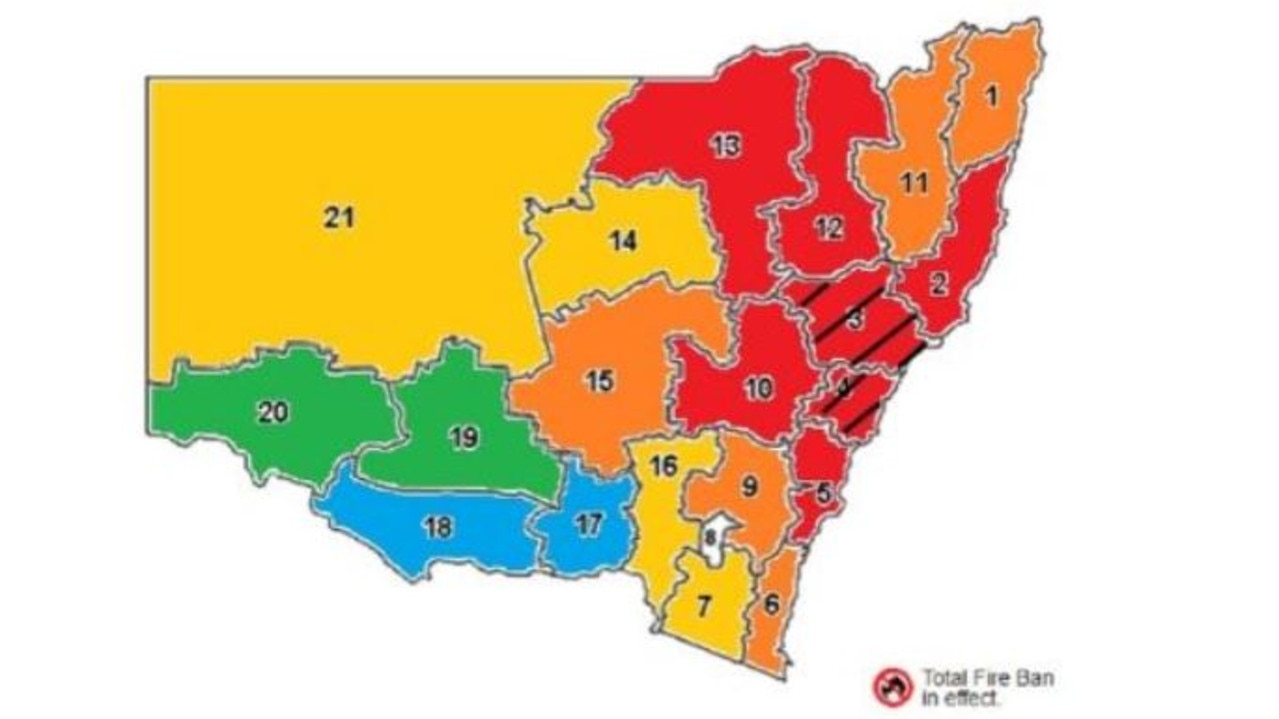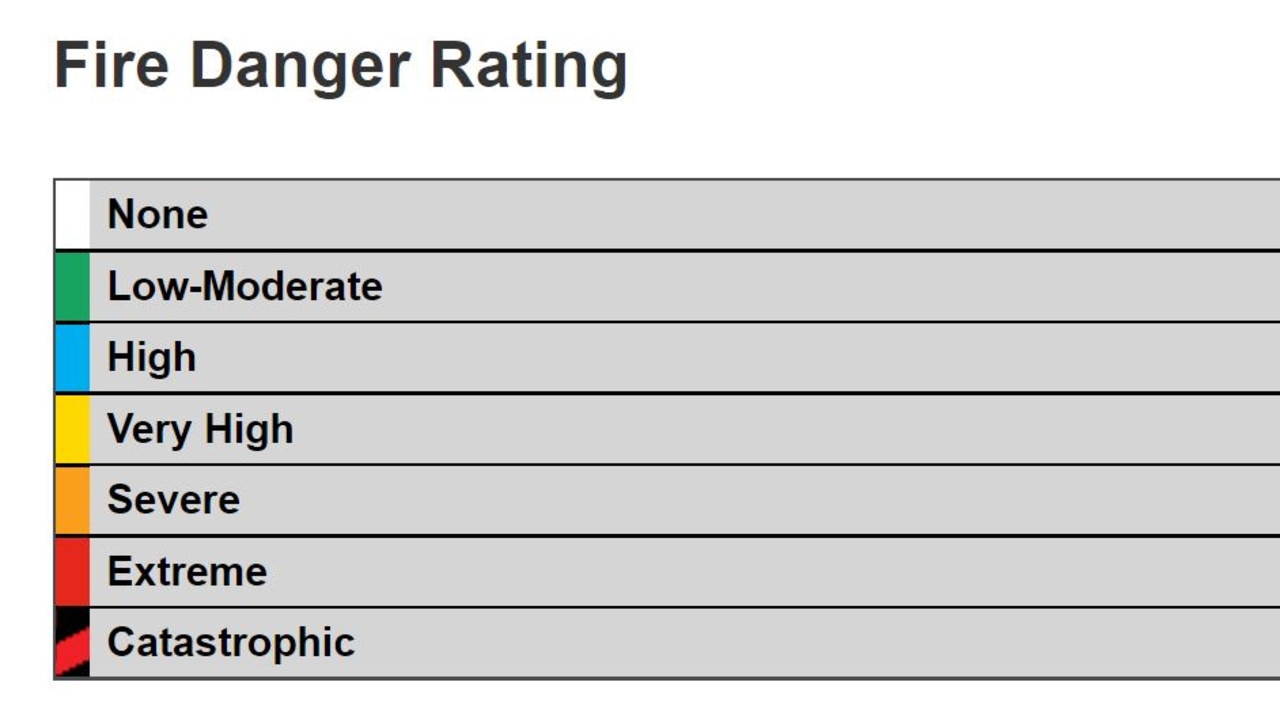‘Worse than originally forecast’: Catastrophic fire danger in Greater Sydney, other areas on Tuesday
A “catastrophic” fire danger rating has been issued for Greater Sydney on Tuesday for the first time in history. Two other regions are now impacted. Here’s what that means.
The NSW Rural Fire Service has issued a “catastrophic” fire danger rating for the Greater Sydney, Greater Hunter and Illawarra/Shoalhaven areas on Tuesday, November 12.
It’s the first time the city has faced the warning since the risk levels were introduced in 2009.
“The fire danger tomorrow is now expected to be worse than originally forecast,” the RFS tweeted on Monday afternoon when the Illawarra/Shoalhaven region was added to the risk.
WHO IS IMPACTED?
Greater Sydney council areas: The Hills; Blacktown; Blue Mountains; Burwood; Camden; Campbelltown; Canada Bay; Fairfield; Hawkesbury; Hornsby; Hunters Hill; Kogarah; Ku-ring-gai; Lane Cove; Liverpool; Mosman; North Sydney; Parramatta; Penrith; Randwick; Ryde; Strathfield; Sutherland; Sydney; Waverley; Willoughby; Woollahra; Bayside; Canterbury-Bankstown; Central Coast; Cumberland; Georges River; Inner West and Northern Beaches.

RELATED: NSW and Qld bushfires: Worst may still be yet to come
Greater Hunter council areas: Cessnock; Dungog; Lake Macquarie; Maitland; Muswellbrook; Newcastle; Port Stephens; Singleton and Upper Hunter.
Illawarra/Shoalhaven council areas: Kiama; Shellharbour; Shoalhaven; Wingecarribee; Wollondilly and Wollongong.
But the RFS has emphasised the danger isn’t limited to the areas facing a catastrophic fire warning.
Inspector Ben Shepherd says there are vast tracts of NSW that will have “severe” or “extreme” fire danger on Tuesday.
Both ratings also come with the advice: “Leaving early is the safest option for your survival.
“We need to ensure that people understand there is a risk in all bushland areas, stretching from Bega all the way to Byron, from the Victorian border to the Queensland border,” Insp Shepherd said in a media alert on Monday.
We are entering an extremely dangerous period of fire danger across NSW - because of the large amount of fires already burning, and increased fire danger ratings. Know the fire danger and what you will do, especially if you're in an area of Catastrophic fire danger. #nswrfs pic.twitter.com/Dm6o23BV5U
— NSW RFS (@NSWRFS) November 10, 2019
WHAT DOES IT MEAN?
NSW RFS Commissioner Shane Fitzsimmons said under these conditions fires can start and spread so quickly that people could be in severe danger before help arrives.
“We cannot guarantee a fire truck, we cannot guarantee an aircraft, we cannot guarantee a knock at the door and we certainly cannot guarantee a telephone message going out,” he told ABC on Monday.
“Leaving early is the safest option for the survivability of you and your loved ones.
“Homes are not designed to withstand the conditions that develop under a catastrophic fire danger rating.”
At a press conference today, he added “you can expect the most extraordinary fire behaviour”.
“It is not without question that spotting activity can be well and truly over 20 kilometres ahead of the main fire front,” the commissioner said.
“Catastrophic conditions are where lives are lost, it’s where people die.
“The volatility and the rapid spread of fire across the landscape, we are rarely able to do anything meaningful when it comes to suppression.
“Our entire focus goes on saving life, focusing on life as first and foremost even all those other things – property and everything – become secondary.”
On Sunday, RFS spokesman Anthony Clark said the catastrophic rating “is as bad as it gets”.
“We’ve got big population centres covered by that catastrophic fire danger – but also up on the north coast where we’ve simply got a lot of fires burning at the moment, those fires have got a real potential to run and impact on lives and properties,” he said.
“So the risk is very real.”

WHAT SHOULD YOU DO?
• For your survival, leaving early is the only option.
• Avoid bush fire prone areas. A safer area may be a large town or city, shopping centres or facilities well away from bushland areas.
• Leave bushfire prone areas the night before or early in the day – do not just wait and see what happens.
• Make a decision about when you will leave, where you will go, how you will get there and when you will return.
• Schools in identified high risk areas will be closed. Schools will notify affected students. Start making arrangements now.
• If you are unable to leave, identify a safe location which may be nearby. This may include a Neighbourhood Safer Place.
The NSW RFS provides fire danger ratings for every region across the state and a map here.
Premier Gladys Berejiklian on Monday declared a state of emergency in NSW for the next seven days.
A statewide total fire ban has also been declared for all of Monday and Tuesday.
– with AAP



